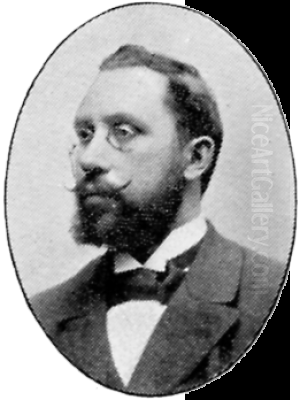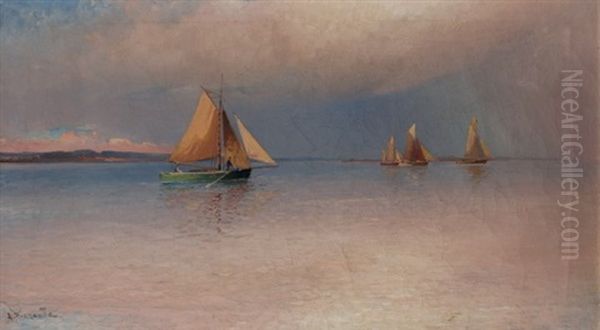
Ludvig Otto Richarde, a notable figure in Swedish art, carved a niche for himself as a painter of maritime scenes, capturing the essence of life at sea and in bustling harbors. His work, though perhaps not as internationally renowned as some of his contemporaries, offers a valuable window into the artistic currents of late 19th and early 20th century Sweden, particularly within the realm of Realism. His dedication to depicting the maritime world provides a fascinating glimpse into Sweden's enduring relationship with the sea.
The Life and Times of a Swedish Artist
Born in 1862, Ludvig Otto Richarde (sometimes spelled Richarade) entered a world where artistic traditions were being challenged and reshaped. Sweden, like much of Europe, was experiencing shifts in artistic sensibilities, moving from the historical romanticism of earlier decades towards a more direct engagement with contemporary life and landscape. Richarde's lifespan, extending to 1929, covered a period of significant artistic evolution, encompassing the flourishing of Realism, Naturalism, the rise of Impressionism's influence in Scandinavia, and the emergence of early modernism.
While specific details about Richarde's early training and artistic education are not extensively documented in readily accessible international sources, it is plausible that he, like many aspiring Swedish artists of his generation, would have sought formal instruction. This might have been at the Royal Swedish Academy of Fine Arts in Stockholm, or perhaps through private tutelage or study in one of the European art centers like Paris, Düsseldorf, or Munich, which attracted many Scandinavian painters seeking to broaden their horizons and engage with new artistic ideas.

The late 19th century in Sweden saw a vibrant art scene. Artists like Anders Zorn, Carl Larsson, and Bruno Liljefors were gaining prominence, each contributing to a distinctly Swedish interpretation of prevailing European styles. Zorn, with his virtuosic brushwork and depictions of Swedish folk life and luminous nudes, and Larsson, with his idyllic portrayals of family life, became national icons. Liljefors, a master of wildlife painting, captured the Swedish landscape and its fauna with remarkable accuracy and atmosphere. These artists, though diverse in their primary subjects, shared a commitment to observation and a strong connection to their native land, an environment in which Richarde would have developed his own artistic voice.
Maritime Realism: Richarde's Chosen Domain
Ludvig Otto Richarde's artistic output indicates a strong predilection for maritime subjects. This focus aligns him with a long tradition of marine painting, both in Scandinavia and internationally. The sea has always been a powerful source of inspiration for artists, offering dynamic compositions, dramatic atmospheric effects, and a rich tapestry of human activity. Richarde's approach appears to be rooted in Realism, an artistic movement that sought to depict subjects truthfully, without artificiality and avoiding exotic or supernatural elements.
For a maritime Realist like Richarde, this would have meant careful observation of ships, water, light, and weather conditions. His paintings likely aimed to convey the tangible reality of harbors, the solidity of vessels, and the ever-changing moods of the sea. This contrasts with the more romanticized or allegorical sea paintings of earlier periods, such as those by the Russian master Ivan Aivazovsky, known for his dramatic and often turbulent seascapes, or the sublime, atmospheric works of the British painter J.M.W. Turner. Richarde's realism would likely be closer in spirit to the more grounded depictions found in some Dutch Golden Age marine art, for instance, the work of artists like Willem van de Velde the Younger, who meticulously documented naval scenes.
The choice of oil as his primary medium, as evidenced by his known works, was typical for Realist painters, allowing for rich color, detailed rendering, and the effective portrayal of light and texture. His focus on harbors and ships suggests an interest in the interplay between human endeavor and the natural environment, a theme common in the art of coastal nations.
Notable Works: Glimpses into Richarde's Oeuvre
Among Ludvig Otto Richarde's documented works, a few titles stand out, offering insight into his artistic concerns and style.
"Out of the Harbour" (1889)
This oil painting, measuring 76 x 58 cm and reportedly housed in the Marialinn Gallery in Helsingborg, Sweden, is dated to 1889. The title itself evokes a scene of departure, a common motif in maritime art. One can imagine a vessel, perhaps a steamship or a sailing ship characteristic of the late 19th century, making its way from the protective confines of a harbor into the open sea. Such a scene would have allowed Richarde to explore the contrast between the structured environment of the port – with its quays, buildings, and other vessels – and the vastness of the water beyond. The year 1889 places this work firmly in a period when Realism was a dominant force, suggesting a depiction characterized by accurate detail and a naturalistic representation of light and atmosphere. The time of day, the weather conditions, and the type of vessel would all have been elements Richarde carefully considered to convey a specific mood and narrative.
"Marina"
Another oil painting, titled "Marina," measures 45 x 78 cm. The creation date for this piece is not definitively known from the provided information, but its subject matter clearly aligns with Richarde's maritime focus. A "marina" or harbor scene would offer a wealth of visual interest: boats at anchor or moored, reflections in the water, the architecture of the waterfront, and perhaps figures engaged in maritime activities. The dimensions suggest a panoramic format, suitable for capturing the breadth of a harbor view. Auction records indicate this piece was sold for €2,750, demonstrating a continued market interest in his work. The signature on this painting is noted as being on the lower left, a common placement for artists.
"Steamship, Seaplane"
The mention of a work titled "Steamship, Seaplane" is particularly intriguing. While the date of this piece isn't provided, the inclusion of a seaplane suggests a later period in Richarde's career, likely in the 1910s or 1920s, as seaplanes became more common after the early pioneering days of aviation. If this is indeed by Richarde, it would indicate his willingness to incorporate modern technological advancements into his traditional maritime themes. This juxtaposition of the established (steamship) and the novel (seaplane) could create a dynamic composition, reflecting a world in transition. It would place him alongside artists like Charles Herbert Woodbury, an American marine painter whose work "The Aviator" (1928) also embraced aeronautical themes within a maritime context.
Richarde in the Context of Scandinavian and International Art
Ludvig Otto Richarde worked during a period of rich artistic exchange and development. In Sweden, artists like Prins Eugen, himself a skilled landscape painter, and the multifaceted August Strindberg, who, alongside his literary achievements, produced powerful and expressive seascapes, were his contemporaries. While Strindberg's approach was often more emotionally charged and proto-expressionistic, his engagement with the sea provides an interesting counterpoint to Richarde's presumed Realism.
The influence of the Skagen Painters, a community of Scandinavian artists who gathered in Skagen, Denmark, from the 1870s, was also significant in the region. Artists like Peder Severin Krøyer and Michael Ancher, with their sun-drenched depictions of coastal life, fishermen, and beach scenes, championed plein air painting and a bright, naturalistic palette. While Richarde's specific connection to this group is unknown, their shared interest in coastal and maritime subjects places them within a similar artistic sphere.
Internationally, the tradition of marine painting was robust. In America, Winslow Homer was creating powerful and often dramatic depictions of the sea and those who made their living from it. His work, characterized by its strong compositions and unsentimental portrayal of nature's force, represents a significant strand of maritime Realism. In France, Impressionists like Claude Monet, though stylistically different, frequently painted harbors and coastal scenes (e.g., "Impression, Sunrise" depicting the port of Le Havre), focusing on the fleeting effects of light and atmosphere. While Richarde's style was likely more grounded in traditional Realism, the broader European interest in capturing the visual realities of contemporary life would have formed part of his artistic environment.
Even looking back, the legacy of Dutch Golden Age marine painters such as Joost van Geel, whose "Pilgrims Embarkation" (1666) shows a detailed approach to maritime scenes, provided a historical foundation for later artists specializing in this genre. Van Geel, influenced by masters like Gabriel Metsu, was known for his meticulous rendering, a quality often valued in Realist traditions.
Richarde's commitment to depicting specific types of vessels, such as steamships, also reflects the technological changes of his era. The transition from sail to steam was a major feature of the 19th century, and artists played a role in documenting this shift. His work can be seen as part of a broader artistic response to the industrial age and its impact on maritime life.
Artistic Style and Characteristics
Based on the titles of his works and the general tenets of Realism prevalent during his active years, several characteristics can be inferred about Richarde's artistic style. He likely prioritized accurate observation and faithful representation. This would involve careful attention to the structure and rigging of ships, the texture of water, and the quality of light. His compositions were probably well-structured, aiming for a balanced and believable depiction of the scene.
The mood of his paintings might have varied, from the bustling activity of a working harbor to the tranquility of ships at anchor or the more dramatic atmosphere of a vessel heading into open waters. His use of color would likely have been naturalistic, reflecting the actual hues of the sea, sky, and man-made structures. Unlike the Impressionists, who broke down color into dabs of paint to capture fleeting light, a Realist like Richarde would typically use more blended brushwork to achieve a smoother, more detailed finish.
His focus on specific locations, such as harbors, suggests an interest in place and the human interaction with it. These were not just generic seascapes but depictions of particular environments, imbued with the character of their maritime activities. The presence of his signature on works like "Marina" underscores the professional artist's mark of authorship and pride in his creation.
Legacy and Conclusion
Ludvig Otto Richarde (1862-1929) remains a representative of a specific strand of Swedish art: maritime Realism. While he may not have achieved the widespread fame of some of his Swedish contemporaries like Zorn or Larsson, or international marine specialists like Homer or Aivazovsky, his work contributes to our understanding of the breadth and depth of artistic practice in Sweden during a transformative period.
His paintings, such as "Out of the Harbour" and "Marina," serve as visual documents of maritime life and technology at the turn of the 20th century. The potential inclusion of modern elements like seaplanes in his later work suggests an artist who was observant of the changing world around him. His dedication to the maritime genre places him in a lineage of artists fascinated by the sea, from the detailed chroniclers of the Dutch Golden Age to the dynamic interpreters of the modern era.
The fact that his works are found in collections like the Marialinn Gallery and appear in auction markets indicates a sustained appreciation for his skill and vision. For art historians and enthusiasts of maritime art, Ludvig Otto Richarde offers a focused and sincere portrayal of the Swedish connection to the sea, rendered with the careful hand of a Realist painter. His art provides a quiet but persistent voice, chronicling the enduring allure and significance of the maritime world. Further research into Swedish art archives and collections would undoubtedly reveal more about this dedicated artist and his contribution to the rich tapestry of Scandinavian art.